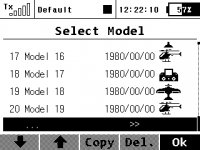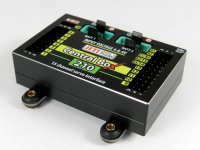1. If I set the alarm for exceeding a height of 450m on my transmitter, I must turn the 3D button for a long time. Is there any quicker way of entering the numeric input?
When editing any numeric input, just push the MENU button, which multiplies the editing by ten. After pushing the MENU button for the second time, the step is multiplied by a hundred. Editing the numeric input can then take place in the following sequence:
Units - Tens - Hundreds - Units...
2. Is it somehow possible to switch off the signal loss alarm after landing and switching the model off?
Push the F(4) Stop or F(5) Delete button on the main screen.
3. The low voltage alarm is played even if the battery voltage ishigher than the set threshold voltage. What does it mean?
Low voltage alarm of receivers is played on the basis of several events:
- The voltage drops below the level set in the transmitter menu "Timers/Sensors - Alarms". In this case the measured voltage is recorded also to a log file with flight records.
- The voltage drops below the value set in the receiver (even for a short time).
- The receiver is reset, i.e. voltage is disconnected from the receiver and then re-supplied to it.
If the alarm starts during the flight, land immediately and check the voltage of receiver power supplies, eventually pay attention to the quality of wiring of the used components.
4. I have created 20 models. If I create some more, I cannot see them in the selection list.
Models in the transmitter are always depicted in tables that consist of maximally 20 items. You can simply switch between the tables: In the Model - Select model menu, scroll with the 3D button all the way down to the bottom of the list. Highlight the line that consists of three periods "... >>" and push the 3D button. Now the next page containing the list of models is displayed. This way it is possible to scroll the whole list until you find the right model.
 |
5. What is the A1 / A2 signal quality?
It is the numerical expression of the signal strength as perceived by the receiver. This value is calculated by the receiver and the transmitter receives it as a telemetry that can be displayed on the display. The number decreases with the distance but does not decrease linearly. It serves only for orientation.
6. What is the Q value?
This is the percentage success rate of the bidirectional communication between the transmitter and the receiver. The transmitter always expects a confirmation of delivery from the receiver, possibly with added telemetry, in each data frame after dispatching servo positions. The resulting signal quality is calculated from the number of confirmed packets per second.



















